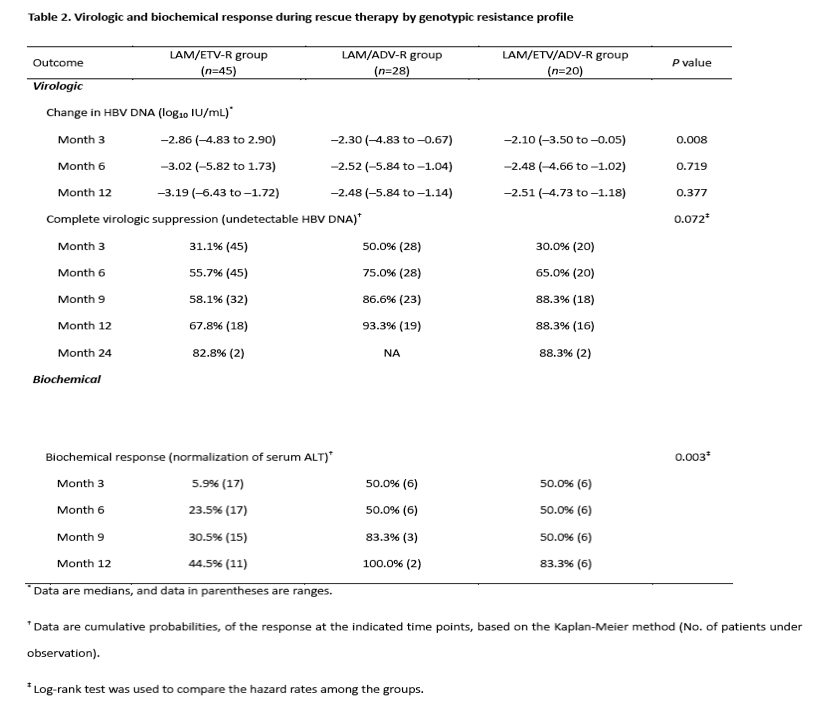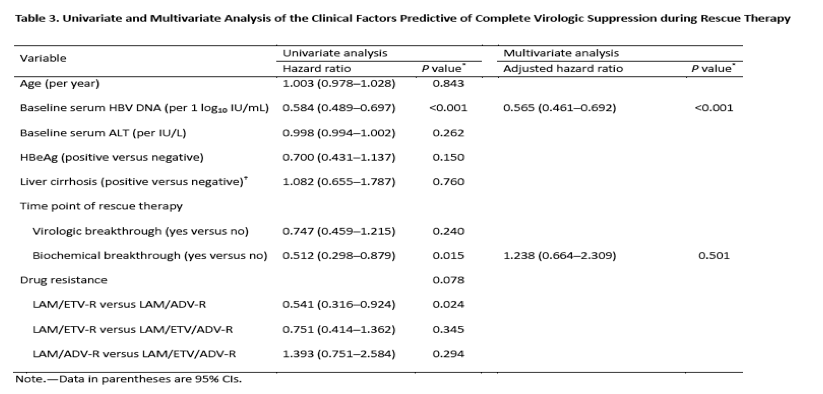 |
 |
 |
| |
Efficacy of Entecavir plus Tenofovir Combination Therapy
for Chronic Hepatitis B Patients with Multi-Drug Resistant Strains
|
| |
| |
Download the PDF here
Download the PDF here
Antimicrob. Agents Chemother
published online ahead of print on 25 August 2014
Yun Bin Lee et al
ABSTRACT
The emergence of multi-drug resistant (MDR) strains of hepatitis B virus (HBV) is a major concern. This study aimed to investigate the efficacy and safety of entecavir (ETV) plus tenofovir disoproxil fumarate (TDF) combination therapy against MDR HBV. To adjust for differences in baseline characteristics, inverse probability weighting (IPW) using propensity scores for the entire cohort and weighted Cox proportional hazards models were applied. Ninety-three consecutive patients who were treated with ETV-TDF combination therapy for >6 months were included; at baseline, 45 were infected with HBV strains with genotypic resistance to lamivudine (LAM) and ETV (the LAM/ETV-R group), 28 to LAM and adefovir (ADV) (the LAM/ADV-R group), and 20 to LAM, ETV, and ADV (the LAM/ETV/ADV-R group). The median duration of rescue therapy was 13.0 (range, 6.7--31.7) months. Seventy-four out of 93 patients (79.6%) achieved complete virologic suppression, after a median 4.5 (95% confidence interval, 3.0--6.0) months. Cumulative probabilities of complete virologic suppression at month 6 were 63.6%: 55.7%, 75.0%, and 65.0% in the LAM/ETV-R, LAM/ADV-R, and LAM/ETV/ADV-R groups, respectively. During the treatment period, these probabilities were not significantly different across the resistance profiles before and after IPW (P=0.072 and P=0.510, respectively). In multivariate analysis, a lower baseline HBV DNA level, but not resistance profiles, was an independent predictor of complete virologic suppression. Renal dysfunction was not observed during the treatment period. In conclusion, rescue therapy with ETV-TDF combination is efficient and safe in patients infected with MDR HBV strains regardless of the antiviral drug resistance profiles.
Excerpts
RESULTS
Overall, 74 of 93 patients (79.6%) achieved complete virologic suppression during the entire treatment period: 32 of 45 (71.1%) in the LAM/ETV-R group, 25 of 28 (89.3%) in the LAM/ADV-R group, and 17 of 20 (85.0%) in the LAM/ETV/ADV-R group. The median time required to reach an undetectable HBV DNA level was 4.5 (95% confidence interval [95% CI], 3.0-6.0) months in all patients: 4.7 (95% CI, 2.3-7.1) months in the LAM/ETV-R group, 3.0 (95% CI, 1.1-4.9) months in the LAM/ADV-R group, and 5.2 (95% CI, 3.6-6.7) months in the LAM/ETV/ADV-R group. The cumulative proportion of complete virologic suppression at month 6 was 63.6% overall: 55.7% in the LAM/ETV-R group, 75.0% in the LAM/ADV-R group, and 65.0% in the LAM/ETV/ADV-R group (Table 2). During the treatment period, there was no significant difference among the groups (P=0.072) (Fig. 2). In multivariate Cox regression analysis, a lower baseline HBV DNA level was independently associated with complete virology suppression (hazard ratio [HR], 0.565; 95% CI, 0.461-0.692; P<0.001) (Table 3). In the entire cohort, the probabilities of complete virologic suppression were significantly influenced by the baseline HBV DNA levels at the beginning of the rescue therapy with ETV-TDF combination (P<0.001). Patients with HBV DNA less than 104 IU/mL had significantly higher probability of achieving complete virological suppression (HR, 8.482; 95% CI, 4.286-16.786; P<0.001) (see Fig. S1 in the supplemental material).


|
| |
|
 |
 |
|
|